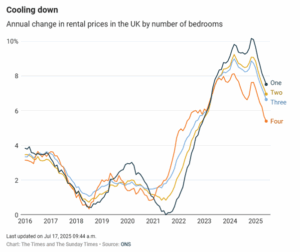The term “generation rent” used to apply to young(ish) people renting a home before they could afford to buy their own. But the moniker has rather lost its meaning in a country where one household in five is now renting.
Tenants and landlords alike can use our rental tracker (see below) to find out if rents have gone up or down in their area.
Across the UK, rents are growing at nearly twice the rate of inflation, analysis of the latest figures from the Office for National Statistics (ONS) shows.
In June, the average monthly rent for all properties in Britain, including both new and existing tenancies, was £1,344, up 6.7 per cent on last year. Consumer price inflation, meanwhile, stands at 3.6 per cent.
Over the past decade, average rents have jumped by 45 per cent, from £924 to £1,344. However, after adjusting for inflation, the increase in real terms is just 4.9 per cent.
How rents have changed
Unsurprisingly, rents in London are growing faster than the average in the UK as a whole. The average monthly rent in the capital is now £2,252 a month, a record high and up 7.3 per cent on a year ago.
However, while average monthly rents in London have risen from £1,620 to £2,252 since 2015 — a jump of 39 per cent — in real terms, renting in London is no more expensive than it was ten years ago.
There are hotspots outside the capital where rent growth has been even stronger than in London, though. For one-bedroom flats, places like Newport in Wales (up 21 per cent on last year), Broxbourne in Hertfordshire (up 17 per cent), Slough in Berkshire (up 14 per cent) and Nuneaton and Bedworth in the West Midlands (up 14 per cent) have seen the biggest increases in the past 12 months.
Check the average monthly rent near you — enter the name of your local authority into the tracker below
Another way of looking at changes in rents is to compare them with wages. The average one-bedroom rental property now costs about 37 per cent of the typical monthly salary, slightly more than two years ago but down on what it was in late 2016, when the property market was red-hot.
In other words, when we adjust for wages, rents have not really increased in price over the past decade.


